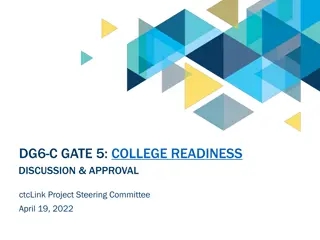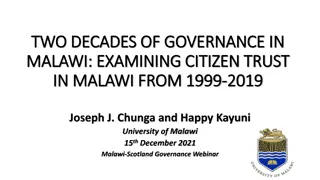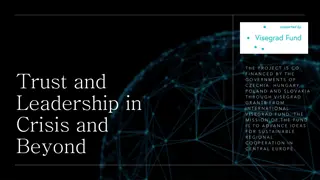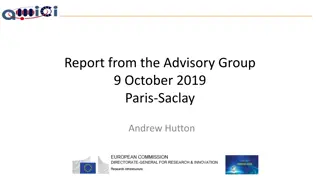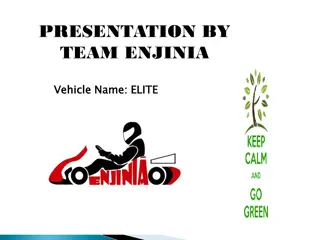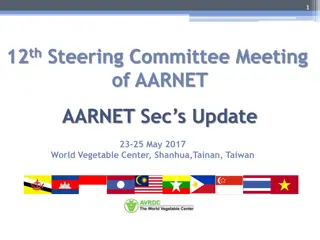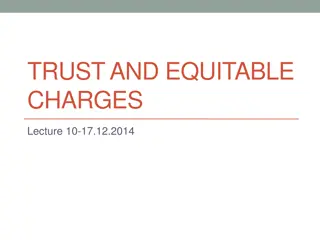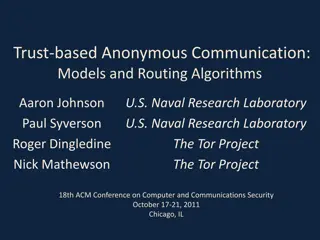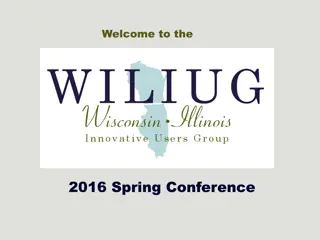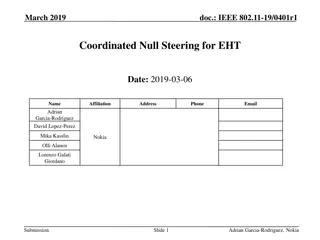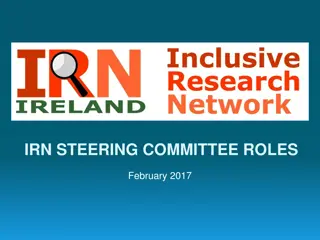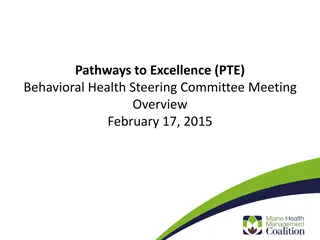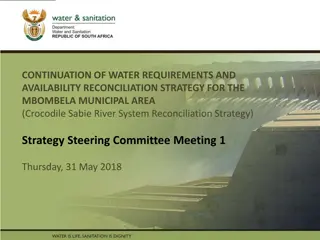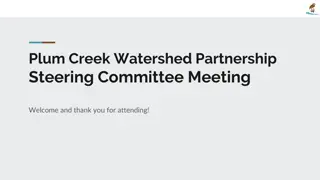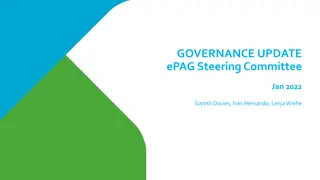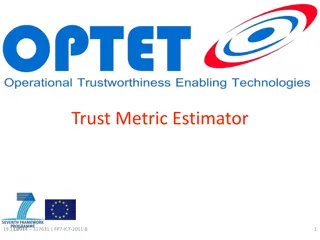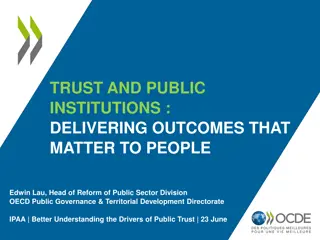Public Trust Steering Committee Workshop Presentation
The workshop by the Canadian Centre for Integrity on March 20th will focus on enhancing public trust through insightful presentations and discussions. Attendees will gain valuable insights into maintaining integrity and fostering trust within organizations.
Download Presentation

Please find below an Image/Link to download the presentation.
The content on the website is provided AS IS for your information and personal use only. It may not be sold, licensed, or shared on other websites without obtaining consent from the author.If you encounter any issues during the download, it is possible that the publisher has removed the file from their server.
You are allowed to download the files provided on this website for personal or commercial use, subject to the condition that they are used lawfully. All files are the property of their respective owners.
The content on the website is provided AS IS for your information and personal use only. It may not be sold, licensed, or shared on other websites without obtaining consent from the author.
E N D
Presentation Transcript
Public Trust Steering Committee March 20th Workshop Canadian Centre for Integrity Presentation
Public Trust Online Survey 2019
Background and Methodology These are the findings from an online Canadian Centre for Food Integrity survey conducted on behalf of the Public Trust Steering Committee Objective: to identify the risks, opportunities, and recommendations to help shape the future for earning trust in Canada s food system. This study took place online from January 17-February 13, 2019 A total of 134 responses were collected (128 respondents are members of a Value Chain Roundtable, 6 are not)
Key Insights Respondents differ significantly from general population Canadians on all questions Concern for public trust most highly rated as a food system macro issue overall (versus a specific company/sector issue) - which ties in with the mostly highly identified need for collaboration and coordination Gaps identified in several key areas between actual/perceived communications best practices versus consumer needs responsibility for providing information versus rating on transparency performance identified risks versus actual consumer concerns out of order
Big Picture Issues Compared to Canadian General Population
We are We are not Is the Canadian food system headed in the right direction? not the target audience. the target audience. 36% Right Direction Unsure 65% 41% Wrong Track 19% 23% 16% 2018 VCRT Canadian Gen Pop Total PTSC Q1. In general, do you think the food system in this country is moving in the right direction, or is off on the wrong track? Base: Canadian Gen Pop 2018 (n=2018) All respondents (n=134) 6
We are We are not Overall Impression of Canadian Agriculture not the target audience. the target audience. % Positive % Positive 55% Canadian Gen Pop 19% 36% 27% 4% 12% 83% Total PTSC 36% 47% 9% 5% % <4 not labelled Q2. Please indicate your overall impression of Canadian agriculture today, would you say it is Base: CCFI Canadian Gen Pop 2018 (n=1509), All Respondents (n=132) 7
Who is responsible responsible for providing information for providing information about how food is grown? Canadians and respondents agree farmers are near the top of the list; governments at 61%. Consumers hold the rest of the food system significantly more responsible than respondents. Gen Pop Gen Pop 8 - 10 (High Level of Responsiblity) - - Farm Organizations 72% 70% 67% 67% Farmers Government 62% 62% 61% 58% Food Processors/Manufacturers Scientific/Academic Researchers Advocacy Groups 73% 73% 50% - 36% 30% 29% - Restaurants Grocery Stores 46% 46% 52% 52% Q5. Using a scale of 0 to 10, please indicate the level of RESPONSIBILITY each of the following groups has in providing information about how food is grown or produced in your industry so consumers can make informed food choices. Give a rating of 0 if you believe they have no responsibility to provide information and a rating of 10 if you believe they have a high level of responsibility to provide information. Base: CCFI Canadian Gen Pop 2017 (n=1307), All respondents (n=103) 8
Key Finding: Transparency Performance Gap Performance Performance Gap Gap 8% Government 53pts 61% 6% Food Processors/Manufacturers 52pts 58% 20% Farmers 50pts 70% 32% Farm Organizations 40pts 72% 12% Scientific/Academic Researchers 38pts 50% 1% Restaurants 30% 29pts 6% Grocery Stores 29% 23pts 15% Advocacy/Special Interest Groups 36% 21pts Doing Very Well (8-10) High Level of Responsibility (8-10) 9
Top Five Agri-Food System Issues of Concern 47 47% % 42 42% % 36 36% % 50 50% % 40 40% % Government Policies and Regulations (International) Government Policies and Regulations (Canada) Public Trust in Canadian Agri-Food Chain Consumer Reactions to New Practices or Technologies Access to International Markets % Very Concerned (8-10) Q3. How concerned are you about the following issues using a scale from 0 to 10 where 0 means you have no concern at all and 10 means you are very concerned about the issue? Base: All respondents 11
Top Risks to Sector/Organization When asked to choose top three 22 22% % 25 25% % 23 23% % 34% 34% 41% 41% Market access Public Policies and Regulations Distrust/misunderstand science/technology Price/cost of food/affordability perception/trust % Very Concerned (8-10) Q4. In your view, please list the top three potential risks to your specific sector and organization. Base: All respondents 12
Public trust is identified most as a food system concern. Level of concerns higher for overall agri-food system. 42 42% % 27 27% % 35 35% % Public trust in Canadian agri-food chain Public trust in my Sector Public trust in my organization/operation % Very Concerned (8-10) Q3. How concerned are you about the following issues using a scale from 0 to 10 where 0 means you have no concern at all and 10 means you are very concerned about the issue? Base: All respondents 13
Impact of Public Perceptions on Operations Predicted to Grow 5 - Very Significant 4 3 2 1 - Not at all Significant Today 24% 38% 27% 10% Next 5 Years 37% 37% 13% 10% 4% 5 - Very Likely 4 3 2 1 - Very Unlikely % <4 not labelled Q7. Q8. How much do public perceptions of the industry impact the way you operate today? In your opinion, what is the likelihood that public perceptions of the industry will impact your ability to operate in the next 5 years? Base: All respondents (n=101) 14
Top Risks within the Public Trust Framework The Hub The Hub (Coordinated Support) Trusted Assurance/ Trusted Assurance/ Verification System Verification System Communication Communication Doing the Right Thing Doing the Right Thing VOLUME OF CREDIBLE INFO FROM CONSUMER FOOD INFLUENCERS IS LOW (49%) LACK OF KNOWLEDGE OF GOV T REGULATIONS OR INSPECTION SYSTEMS (40%) CONCERNS ABOUT TREATMENT OF LIVESTOCK & POULTRY (47%) VOLUME OF INFO FROM CRITICS IS HIGH (48%) LACK OF KNOWLEDGE OF QA PRACTICES (37%) CRISIS EVENT WITHIN SECTOR (46%) VOLUME OF CREDIBLE INFO FROM EXPERTS IS LOW (37%) LACK OF CONFIDENCE IN GOV T INSPECTIONS OR STANDARD ENFORCEMENT (36%) USE OF FARM CHEMICALS (42%) .. Transparency .. .. Transparency .. .. Continuous Improvement .. .. Continuous Improvement .. % Very High Risk (8-10) 15
Most Effective Public Trust Building Activities 46 46% % 65 65% % 57 57% % 52 52% % 47% Companies taking responsibility when there is a food safety recall or other incident Public Sharing authentic information open and transparently, including areas needing improvement Including key stakeholders in action planning, key message development and citing them in communications Creating a coordinated communications strategy to earn trust in Canadian food system with consumers communications from farmers about our sector % = Extremely Effective (8-10) Q10. Listed below are some activities that have been undertaken to gain public trust. Based on your experience, please rate the effectiveness of each of the following using a scale of 0 to 10 where 0 is not effective at all and 10 is extremely effective to improving trust Base: All respondents 17
Top Current Practices 33 33% % 52 52% % 47 47% % 45 45% % 42% We invest in 3rd party efforts together with many others in the food system to be more effective in earning trust We communicate our business practices and science-based rational to the public When developing our policies, third party experts are consulted. Organization invests in earning public trust as foundational part of our success When communicating policies publicly, credible 3rd party experts who were consulted are cited % = Always (8-10) Q11. Please rate your level of agreement with each of the statements below when it comes to current practices that your company / organization uses. Base: All respondents 18
Views of Top Current Practices Disconnect with Measured Effective Ways of Earning Trust 33 33% % 30% When communicating policies publicly, credible 3rd party experts who were consulted are cited Communications start with values and beliefs before we communicate facts % = Always (8-10) Q11. Please rate your level of agreement with each of the statements below when it comes to current practices that your company / organization uses. Base: All respondents 19
Messages/Practices to be Highlighted Food safety 39% Sustainability/environmental 37% Government/independent assurance systems 22% Reliance on science-based best management practices 18% Nutrition/health 16% Animal welfare 13% Addressing consumer concerns transparently/false claims on social media 10% Shared values/emotions/social 10% Continuous improvements/innovation 10% Quality of food 7% Stakeholder engagement (public institutions, farmers, dietitians, academics) 6% Affordabilty 4% Other 13% Q12. What messages or practices within your sector should be highlighted to the public? Base: All respondents (n=82) 20
Improving Public Trust: Agri Agri- -Food System Overall Food System Overall What to Stop What to Stop What to do Better What to do Better 26% 23% Coordination/collaboration Poor communication 18% Communication (General) 25% Being defensive/arrogant/preachy 15% Transparency 18% Segregation/competition 13% Government/regulatory response 13% Avoiding activists/critics 10% Engage/educate/communicate with public Avoiding science-based information/technology 10% 9% Connect with shared values/story-telling Not adopting best practices/resistance to change 8% 8% Adopt and follow best practices/standards 7% Engaging with activists/critics 8% Open to consumer concerns/difficult conversations 6% Avoiding action/responsibility 8% Food safety 15% 10% Other Other % <5 not displayed Q13b. Q14a. What is one thing the agri-food system overall could do better to improve trust? Base: All respondents (n=80) What is one thing the agri-food system overall should stop doing to better improve trust? Base: All respondents (n=1509) 22
Improving Public Trust: Sector Sector- -Specific Specific What to do Better What to do Better What to Stop What to Stop Better/improved communication 38% Poor communication 27% Being Improved collaboration/coordination 13% 26% defensive/arrogant/preachy Communication (Production practices) 11% Avoiding action/responsibility 23% Increase role of farmers 6% Sector segregation/competition 15% Demonstrate/communicate science- based approaches Not adopting best practices/resistance to change 6% 15% Consumer education 6% Lack of transparency 5% Other Other 17% 6% % <5 not displayed Q13a. Q14b. What is one thing your sector specifically could do better to improve trust? Base: All respondents (n=82) What is one thing your sector specifically should stop doing to better improve trust? Base: All respondents (n=62) 23
Mind the Gaps Mind the Gaps Messages/Practices/Risks Gap There is a gap between perceived and known practices to build trust, as well as a second gap to the risks. Respondents are nearly twice as likely to cite science-based information as important to share with Canadians than shared values/emotion based messaging. CCFI 2016 Public Trust research illustrates the latter to be 3-5 times more effective for earning trust. The same research revealed third-party stakeholder engagement and messaging to be viewed positively by Canadians for both credibility and transparency, yet is only cited by 6% of respondents. Only 13% named animal welfare as a topic area to highlight for messages yet it received the highest risk rating in the do the right thing pillar of this research. The disconnect with the CCFI public trust research with consumers also shows the largest gap between trust and responsibility on animal welfare. 24
Interested in this work? Keep in touch. Sign up for CCFI e-news to get monthly updates and invites to webinars, events, research highlights at www.foodintegrity.ca @foodintegrityCA Save the date! Public Trust Summit November 13 co-hosted with Farm & Food Care SK November 13- -14th Saskatoon 14th Saskatoon,




